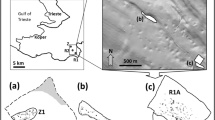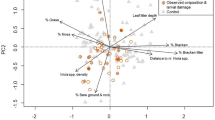Summary
TheDrosophila community of Kipuka Puaulu, Hawaii Volcanoes National Park, was studied by field measurements and laboratory experiments. Phototactic responses were related to oviposition substrates forD. mimica andD. imparisetae, and were shown to reinforce substrate attractiveness. Both species were associated with rottingSapindus fruit, butD. imparisetae, less light tolerant thanD. mimica, was found in deeper shade. Individuals of a third species,D. kambysellisi, were strongly attracted to substratePisonia leaves. The attraction was strong enough to override strong positive phototaxis. The significance of this behavior was related to the adaptive strategy of the species. The sibling species,D. mimica andD. kambysellisi, utilized different substrates and were strongly separated spatially. Differences in substrates and mobility were related to the “grain size” of their environment. Males ofD. kambysellisi andD. imparisetae are located in leking sites above their respective females during the day. This behavior parallels the relatively greater light tolerance of males than of females. The same light response dimorphism inD. mimica is not accompanied by leking behavior, since they mate at night or in greatly subdued light.
Similar content being viewed by others
References
Bush, G. L.: Sympatric host race formation and speciation in frugivorous flies of the genusRhagoletis (Diptera, Tephritidae). Evolution23, 237–251 (1969)
Bush, G. L.: The mechanism of sympatric host race formation in the true fruit flies (Tephritidae). In: Genetic mechanisms of speciation in insects, p. 3–23, M.J.D. White, ed. Sydney: Australia and New Zealand Book Co. 1974
Carson, H. L.: Chromosome tracers of the origin of species. Science168, 1414–1418 (1970)
Carson, H. L., Hardy, D. E., Spieth, H. T., Stone, W. S.: The evolutionary biology of the Hawaiian Drosophilidae. In: Essays in evolution and genetics, p. 437–544, Max K. Hecht, William C. Steere, eds. New York: Appleton-Century-Crofts 1970
Grossfield, J.: Visual stimuli in the biology of the HawaiianDrosophila. In: Studies in genetics IV, M. R. Wheeler, ed. Univ. Texas Publ. No.6818, 301–417 (1968)
Hardy, D. E.: Insects of Hawaii, vol. 12, Diptera: Cyclorrhapha II, Series Schizophora, sect. Acalypterae, I. Family Drosophilidae, 814 pp. Honolulu: Univ. Hawaii Press 1965
Heed, W. B.: Ecology of the Hawaiian Drosophilidae. In: Studies in genetics IV, M.R. Wheeler, ed. Univ. Texas Publ. No.6818, 387–419 (1968)
Heed, W. B.: Host plant specificity and speciation in HawaiianDrosophila. Taxon20, 115–121 (1971)
Johnston, J. S.: Dispersal in desert-adaptedDrosophila. Ph. D. Dissertation, Tucson, University of Arizona (1972)
Kambysellis, M. P., Heed, W. B.: Studies in oogenesis in natural populations of Drosophilidae: I. Relation of ovarian development and ecological habitats of the Hawaiian species. Amer. Nat.105, 31–49 (1971)
Levins, R.: Evolution in changing environments, 120 pp. Princeton, New Jersey: Princeton University Press 1968
MacArthur, R. H., Wilson, E. O.: The theory of island biogeography, 203 pp. Princeton, New Jersey: Princeton University Press 1967
Macdonald, G. A., Abbott, A. T.: Volcanoes in the sea, 441 pp. Honolulu: The University Press of Hawaii 1970
Richardson, R. H.: Effects of dispersal, habitat selection, and competition on a speciation pattern ofDrosophila endemic to Hawaii. In: Genetic analysis and speciation mechanisms, p. 140–164, M.J.D. White, ed. Sydney: Australia and New Zealand Book Co. 1974
Richardson, R. H., Johnston, J. S.: Behavioral components of dispersal inDrosophila mimica. Oecologia (Berl.)20, 287–299 (1975)
Rockwood, E. S.: Enzyme variation in natural populations ofDrosophila. In: Studies in genetics V, M. R. Wheeler, ed. Univ. Texas Publ. No.6618, 111–132 (1969)
Smathers, G.A.: A report on the microclimates in two Hawaiian kipukas (in support of HAVO-N-8). Hawaii Volcanoes National Park (Mimeograph) (1968)
Spieth, H. T.: Courtship behavior of endemic HawaiianDrosophila. In: Studies in genetics III, M. R. Wheeler, ed. Univ. Texas Publ. No.6615, 245–313 (1966)
Throckmorton, L. H.: The relationships of the endemic Hawaiian Drosophilidae. In: Studies in genetics III, M. R. Wheeler, ed. Univ. Texas Publ.6615, 335–396 (1966)
Author information
Authors and Affiliations
Additional information
Supported by AEC Contract No. AT-(40-1)-4023.
Supported by NIH Research Career Development Award GM 47350.
Postdoctoral Trainee, NIH Training Grant 5 TO1 GM 00337-13.
Rights and permissions
About this article
Cite this article
Richardson, R.H., Johnston, J.S. Ecological specialization of HawaiianDrosophila . Oecologia 21, 193–204 (1975). https://doi.org/10.1007/BF02404672
Received:
Issue Date:
DOI: https://doi.org/10.1007/BF02404672




